Ruth Tighe publishes a weekly online commentary about life in Saipan. This week she gave a plug for our Stream Team interview with Dr. Teny Topalian.
Click HERE to read On My Mind by Ruth Tighe
On the air this week: Angelo Villagomez and Jeremy Shaw on KZMI on Saturday, KCNM on Sunday at 9:00 a.m., interviewed by Teny Topalian about the stream team and related projects.
Thanks, Ruth!
Friday, June 30, 2006
In the news again
Beautify CNMI to plant more trees
By Cherrie Anne E. Villahermosa
Variety News Staff
BEAUTIFY CNMI will conduct another tree planting activity on Beach Road this weekend.
The tree planting activity spearheaded by the group’s restoration subcommittee will start at 8 a.m. on Sunday.
Beautify CNMI group will be joined by members of MOVERS, an organization of Filipino workers on island.
They will plant trees in the areas between Saipan Gold Beach Hotel and the 13th Fishermen Pavilion.
This will be the third time that Beautify CNMI will plant trees along Beach Road.
The group’s first tree planting activity was held on June 19 near the 13th Fishermen pavilion. The plants were donated by the Division of Parks and Recreation.
On Sunday, June 25, the group and MOVERS planted seven flame trees in the area across from the Naked Fish restaurant.
Angelo Villagomez, public involvement coordinator for the Marianas Resource Conservation & Development Council Inc., said the volunteers had to break through a layer of compacted coral fill to get to the underlying soil.
Villagomez said the newly planted trees will replace those that have been damaged or destroyed.
The tree planting activity is part of the campaign to restore the natural beauty of the island.
Villagomez said they will work with local businesses and students of Northern Marianas College for their next tree planting project.
Their next target areas are along Middle Road, from Pizza Hut to the Chalan Monsignor intersection, the road to the airport from the Guangdong Hardware intersection, Airport Road, and the section of Middle Road going to Marpi.
Villagomez said they need more volunteers for tree planting activities.
Anyone who wants to contribute ideas, donate plants, drinking water, food or backhoes or provide any other assistance to Beautify CNMI can call the Marianas Resource Conservation & Development Council Inc. office at 236-0894.
Beautify CNMI is a coalition of government agencies as well as private sector and community organizations.
By Cherrie Anne E. Villahermosa
Variety News Staff
BEAUTIFY CNMI will conduct another tree planting activity on Beach Road this weekend.
The tree planting activity spearheaded by the group’s restoration subcommittee will start at 8 a.m. on Sunday.
Beautify CNMI group will be joined by members of MOVERS, an organization of Filipino workers on island.
They will plant trees in the areas between Saipan Gold Beach Hotel and the 13th Fishermen Pavilion.
This will be the third time that Beautify CNMI will plant trees along Beach Road.
The group’s first tree planting activity was held on June 19 near the 13th Fishermen pavilion. The plants were donated by the Division of Parks and Recreation.
On Sunday, June 25, the group and MOVERS planted seven flame trees in the area across from the Naked Fish restaurant.
Angelo Villagomez, public involvement coordinator for the Marianas Resource Conservation & Development Council Inc., said the volunteers had to break through a layer of compacted coral fill to get to the underlying soil.
Villagomez said the newly planted trees will replace those that have been damaged or destroyed.
The tree planting activity is part of the campaign to restore the natural beauty of the island.
Villagomez said they will work with local businesses and students of Northern Marianas College for their next tree planting project.
Their next target areas are along Middle Road, from Pizza Hut to the Chalan Monsignor intersection, the road to the airport from the Guangdong Hardware intersection, Airport Road, and the section of Middle Road going to Marpi.
Villagomez said they need more volunteers for tree planting activities.
Anyone who wants to contribute ideas, donate plants, drinking water, food or backhoes or provide any other assistance to Beautify CNMI can call the Marianas Resource Conservation & Development Council Inc. office at 236-0894.
Beautify CNMI is a coalition of government agencies as well as private sector and community organizations.
Thursday, June 29, 2006
Tree Plantings in the News
Saipan Tribune, Thursday, June 29, 2006
Digging for trees
The beauticians of the Beautify CNMI! campaign are at it again-and this time they are digging for trees. On Sunday, June 25, volunteers gathered to "quarry" the rocky soil alongside Beach Road and plant seven flame trees.
Volunteers had to break through a layer of compacted coral fill to get to the underlying soil. Only after several inches of coral were extracted could the volunteers set aside their picks in favor of shovels.
The new trees replaced those that had been damaged or destroyed. The Department of Parks and Recreation donated the trees, while MOVERS, a Filipino volunteer organization, provided much of the brawn. Beautify CNMI! volunteers Corie Borja, Bob Schwalbach, Glen Hunter, Jed Horey, Capt. Carl Brachear, Gus Kaipat, and Josiah Lizama also supplied their muscle and sweat. Ken Kramer, Tina Sablan, and Angelo Villagomez, chairpersons within the Beautify CNMI! campaign, coordinated the event.
Beautify CNMI! is a coalition of citizens, private/volunteer groups and governmental entities united to enhance Saipan 's natural beauty for the benefit of its residents and visitors. The group identifies opportunities to collaborate with others, and then turns ideas into actions that improve the environment.
In their next project, Beautify CNMI! will work with businesses and students of the Northern Marianas Collage to plant trees and shrubs along Middle Road, from Pizza Hut to the Chalan Monsignor intersection. The students, members of Sam McPhetre's Current Issues class, will assist in creating a landscaping plan. Future planting areas include the road to the airport from the Guangdong Hardware intersection; Airport Road; and the section of Middle Road going to Marpi.
Saipan and the rest of the Marianas need more hardworking volunteers to plant trees. Anyone who wishes to contribute ideas, donate plants (or backhoes!), or volunteer assistance to Beautify CNMI can attend the next Restoration Subcommittee meeting. More details are available at Angelo Villagomez's blog at: hafa-adai.blogspot.com. Anyone interested in becoming an Earth Team Volunteer should contact Anton Tornito on Guam at (671) 472-7156, or antonette.tornito@pb.usda.gov. (PR)
Digging for trees
The beauticians of the Beautify CNMI! campaign are at it again-and this time they are digging for trees. On Sunday, June 25, volunteers gathered to "quarry" the rocky soil alongside Beach Road and plant seven flame trees.
Volunteers had to break through a layer of compacted coral fill to get to the underlying soil. Only after several inches of coral were extracted could the volunteers set aside their picks in favor of shovels.
The new trees replaced those that had been damaged or destroyed. The Department of Parks and Recreation donated the trees, while MOVERS, a Filipino volunteer organization, provided much of the brawn. Beautify CNMI! volunteers Corie Borja, Bob Schwalbach, Glen Hunter, Jed Horey, Capt. Carl Brachear, Gus Kaipat, and Josiah Lizama also supplied their muscle and sweat. Ken Kramer, Tina Sablan, and Angelo Villagomez, chairpersons within the Beautify CNMI! campaign, coordinated the event.
Beautify CNMI! is a coalition of citizens, private/volunteer groups and governmental entities united to enhance Saipan 's natural beauty for the benefit of its residents and visitors. The group identifies opportunities to collaborate with others, and then turns ideas into actions that improve the environment.
In their next project, Beautify CNMI! will work with businesses and students of the Northern Marianas Collage to plant trees and shrubs along Middle Road, from Pizza Hut to the Chalan Monsignor intersection. The students, members of Sam McPhetre's Current Issues class, will assist in creating a landscaping plan. Future planting areas include the road to the airport from the Guangdong Hardware intersection; Airport Road; and the section of Middle Road going to Marpi.
Saipan and the rest of the Marianas need more hardworking volunteers to plant trees. Anyone who wishes to contribute ideas, donate plants (or backhoes!), or volunteer assistance to Beautify CNMI can attend the next Restoration Subcommittee meeting. More details are available at Angelo Villagomez's blog at: hafa-adai.blogspot.com. Anyone interested in becoming an Earth Team Volunteer should contact Anton Tornito on Guam at (671) 472-7156, or antonette.tornito@pb.usda.gov. (PR)
Wednesday, June 28, 2006
Monday, June 26, 2006
Local People Solving Local Problems
This Editorial appeared on the pages of the Marianas Variety on Friday, June 23, 2006:
We all have to pitch in
By Zaldy Dandan
Variety Editor
A COALITION of government agencies and private sector organizations, Beautify CNMI, has begun its tree planting activities and has put up a recycling booth at the Liberation carnival grounds across from the Kristo Rai Church.
This new group is one of the many organizations out there that are taking the initiative to do what must be done to make these islands a better place not only for visitors but for residents as well.
With the government broke and scraping for funds for its many obligations, residents will have to rely more and more on their own efforts to get most things done. The government cannot do everything for us. Nor should it do so.
Ensuring that we all live in a healthy, clean and safe environment is a never-ending task that requires all of us to do our part. It makes perfect economic sense to make this place more attractive to visitors. And it is common sense to help clean up the place we call home.
We are hoping that more groups, more communities and more individuals will lend a hand to Beautify CNMI.
(For more information, call DEQ at 664-8500 or Marianas Resource Conservation & Development at 236-0894.)
We all have to pitch in
By Zaldy Dandan
Variety Editor
A COALITION of government agencies and private sector organizations, Beautify CNMI, has begun its tree planting activities and has put up a recycling booth at the Liberation carnival grounds across from the Kristo Rai Church.
This new group is one of the many organizations out there that are taking the initiative to do what must be done to make these islands a better place not only for visitors but for residents as well.
With the government broke and scraping for funds for its many obligations, residents will have to rely more and more on their own efforts to get most things done. The government cannot do everything for us. Nor should it do so.
Ensuring that we all live in a healthy, clean and safe environment is a never-ending task that requires all of us to do our part. It makes perfect economic sense to make this place more attractive to visitors. And it is common sense to help clean up the place we call home.
We are hoping that more groups, more communities and more individuals will lend a hand to Beautify CNMI.
(For more information, call DEQ at 664-8500 or Marianas Resource Conservation & Development at 236-0894.)
Sunday, June 25, 2006
MOVER's First Tree Planting
Marianas RC&D and Beautify CNMI are teaming up to replace some of the dying trees along Beach Road. We have plans to extend this program island wide, but first we want to replace the unhealthy (or missing) flame trees (Delonix regia), which are the CNMI's official tree, along the length of Beach Road. We also have plans to plant coconut trees along the edge of the beach, but we have a little more work to do before we can start planting them. Some of the government entities are hesitant to plant coconuts because they are afraid of falling coconuts killing a tourist.
Beautify CNMI kicked off the tree planting last Monday with a ceremony along Beach Road. Rep. Cinta Kaipat, Saipan Mayor Juan. B. Tudela, restoration subcommittee chair and acting Marianas Resource Conservation & Development Council Coordinator Ken Kramer, Division of Parks and Recreation director Tony T. Benavente, and Department of Public Works special project coordinator Joseph Muna Mendiola led the ceremonial shoveling of soil for the first planted tree using golden shovels.
They planted four trees on Monday.
This morning we planted 7 more and we couldn't have done it without the help of MOVER, a local community group.
They came to the RC&D office on Friday to inquire as to how they could get involved in Beautify CNMI. More specifically, they wanted to know how they could help us plant trees.
We said that we could probably get something together by the middle of next week, but that wasn't good enough for them. They wanted to do something NOW! Joe from Parks & Recreation said he could get us some trees if we drove over to pick them up, so that's what we did.
The planting on Monday was 80% ceremony and 20% tree planting, but this morning's planting was all about getting trees in the ground. On Monday they had the luxury of a backhoe. This morning we used shovels and picks.
 I was more than a little discouraged when we started digging. I didn't realize that we'd be digging through compacted coral aggregate. The shovels alone were useless. We had to break up the coral with the picks first. (After about five inches of coral we reached soil, so don't think that we were wasting our time by planting trees on top of rock.)
I was more than a little discouraged when we started digging. I didn't realize that we'd be digging through compacted coral aggregate. The shovels alone were useless. We had to break up the coral with the picks first. (After about five inches of coral we reached soil, so don't think that we were wasting our time by planting trees on top of rock.)
The MOVER volunteers were amazing. From the smiles that were on everyone's faces the entire morning, you would have never guessed that we were digging through rock.
 Here's Captain Carl taking a couple whacks with the pick:
Here's Captain Carl taking a couple whacks with the pick:
 This is the first tree being put in the ground. The MOVER President, Marites, is about to throw in the first shovel of dirt:
This is the first tree being put in the ground. The MOVER President, Marites, is about to throw in the first shovel of dirt:
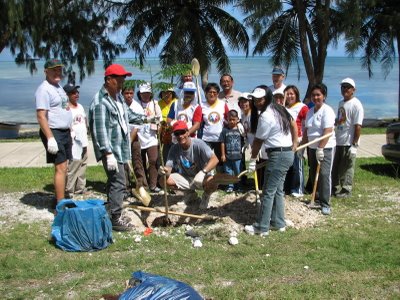 Here's Ken showing the MOVER volunteers how to properly plant a tree. After he showed them how to do it, they split up and planted the other 6 trees:
Here's Ken showing the MOVER volunteers how to properly plant a tree. After he showed them how to do it, they split up and planted the other 6 trees:
 Representative Cinta Kaipat stopped by to thank us for our work. Here she is talking to and posing with the volunteers (photos courtesy of Gus Kaipat):
Representative Cinta Kaipat stopped by to thank us for our work. Here she is talking to and posing with the volunteers (photos courtesy of Gus Kaipat):
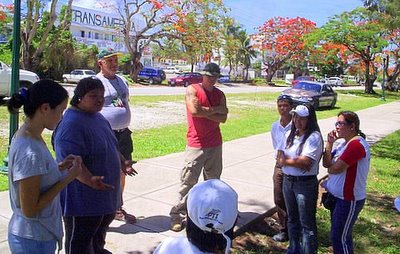
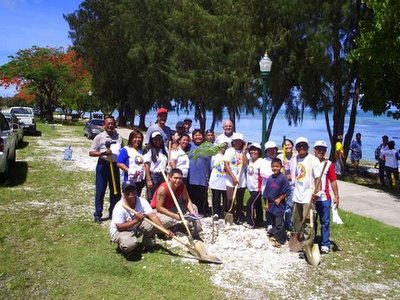 And the last tree of the day going in the ground:
And the last tree of the day going in the ground:
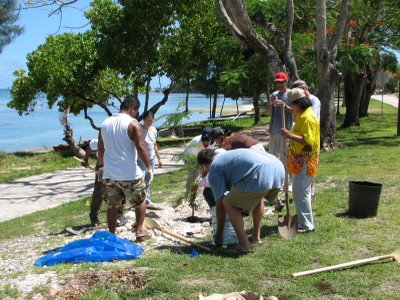
Beautify CNMI kicked off the tree planting last Monday with a ceremony along Beach Road. Rep. Cinta Kaipat, Saipan Mayor Juan. B. Tudela, restoration subcommittee chair and acting Marianas Resource Conservation & Development Council Coordinator Ken Kramer, Division of Parks and Recreation director Tony T. Benavente, and Department of Public Works special project coordinator Joseph Muna Mendiola led the ceremonial shoveling of soil for the first planted tree using golden shovels.
They planted four trees on Monday.
This morning we planted 7 more and we couldn't have done it without the help of MOVER, a local community group.
They came to the RC&D office on Friday to inquire as to how they could get involved in Beautify CNMI. More specifically, they wanted to know how they could help us plant trees.
We said that we could probably get something together by the middle of next week, but that wasn't good enough for them. They wanted to do something NOW! Joe from Parks & Recreation said he could get us some trees if we drove over to pick them up, so that's what we did.
The planting on Monday was 80% ceremony and 20% tree planting, but this morning's planting was all about getting trees in the ground. On Monday they had the luxury of a backhoe. This morning we used shovels and picks.
 I was more than a little discouraged when we started digging. I didn't realize that we'd be digging through compacted coral aggregate. The shovels alone were useless. We had to break up the coral with the picks first. (After about five inches of coral we reached soil, so don't think that we were wasting our time by planting trees on top of rock.)
I was more than a little discouraged when we started digging. I didn't realize that we'd be digging through compacted coral aggregate. The shovels alone were useless. We had to break up the coral with the picks first. (After about five inches of coral we reached soil, so don't think that we were wasting our time by planting trees on top of rock.)The MOVER volunteers were amazing. From the smiles that were on everyone's faces the entire morning, you would have never guessed that we were digging through rock.
 Here's Captain Carl taking a couple whacks with the pick:
Here's Captain Carl taking a couple whacks with the pick: This is the first tree being put in the ground. The MOVER President, Marites, is about to throw in the first shovel of dirt:
This is the first tree being put in the ground. The MOVER President, Marites, is about to throw in the first shovel of dirt: Here's Ken showing the MOVER volunteers how to properly plant a tree. After he showed them how to do it, they split up and planted the other 6 trees:
Here's Ken showing the MOVER volunteers how to properly plant a tree. After he showed them how to do it, they split up and planted the other 6 trees: Representative Cinta Kaipat stopped by to thank us for our work. Here she is talking to and posing with the volunteers (photos courtesy of Gus Kaipat):
Representative Cinta Kaipat stopped by to thank us for our work. Here she is talking to and posing with the volunteers (photos courtesy of Gus Kaipat):
 And the last tree of the day going in the ground:
And the last tree of the day going in the ground:
Thursday, June 22, 2006
Join the Stream Team!
Want to make a difference in the health of our environment? Join the STREAM TEAM! The CNMI Division of Environmental Quality and the Marianas Resource Conservation & Development Council is seeking dedicated individuals to join the CNMI Stream Team, a community-based organization supported jointly by DEQ and the MRC&D. The primary purposes of the Stream Team are to:
• Involve local people in solving local problems
• Monitor storm runoff for water quality
• Participate in stream cleanups
• Restore degraded streams
• Educate the public about environmental issues
Why do we care about the quality of our streams? Everything that takes place on land affects the marine environment. Eroded sediment and other pollutants from even the most remote locations of our islands are carried by storm runoff into streams, to be ultimately deposited in our coastal waters. These processes, which are strongly affected by land use practices, play a significant role in determining the quality of our beaches, coral reefs, and fish populations.
No experience is necessary, as we will teach you everything that you need to know. The only requirements to being a Stream Team member are an interest in environmental issues, a willingness to learn, and a commitment to making a difference in the quality of our environment.
How do I sign up? Our first meeting is going to be Wednesday, June 28 at 5:30 PM at the Aquarius Hotel Meeting Room. DEQ and MRC&D will discuss volunteer opportunites and answer any questions at the meeting. To sign up, or for more information, please contact:
Angelo Villagomez
Public Involvement Coordinator
Marianas RC&D
(670) 236-0894
angelo_villagomez@hotmail.com
Jeremy Shaw
Watershed Coordinator
CNMI Division of Environmental Quality
(670) 664 8517
jeremyshaw@deq.gov.mp
• Involve local people in solving local problems
• Monitor storm runoff for water quality
• Participate in stream cleanups
• Restore degraded streams
• Educate the public about environmental issues
Why do we care about the quality of our streams? Everything that takes place on land affects the marine environment. Eroded sediment and other pollutants from even the most remote locations of our islands are carried by storm runoff into streams, to be ultimately deposited in our coastal waters. These processes, which are strongly affected by land use practices, play a significant role in determining the quality of our beaches, coral reefs, and fish populations.
No experience is necessary, as we will teach you everything that you need to know. The only requirements to being a Stream Team member are an interest in environmental issues, a willingness to learn, and a commitment to making a difference in the quality of our environment.
How do I sign up? Our first meeting is going to be Wednesday, June 28 at 5:30 PM at the Aquarius Hotel Meeting Room. DEQ and MRC&D will discuss volunteer opportunites and answer any questions at the meeting. To sign up, or for more information, please contact:
Angelo Villagomez
Public Involvement Coordinator
Marianas RC&D
(670) 236-0894
angelo_villagomez@hotmail.com
Jeremy Shaw
Watershed Coordinator
CNMI Division of Environmental Quality
(670) 664 8517
jeremyshaw@deq.gov.mp
Wednesday, June 21, 2006
Biosearch Survey
The Marianas Resource Conservation & Development Council is teaming up with Coastal Resources Management to implement an island wide macrofauna survey.
We are looking for volunteer divers to fill out a Reef Report Dive Log after they finish their dives. Any serious diver should already be filling out a dive log, so it should only take a minute or two to transfer that data over to our data log.
This data will help us monitor the health of our reefs and over the long term will help divers determine the best time and place to see marine life.
Click HERE to download the Biosearch Reef Report Dive Log.
After you fill out the form, please return it to Angelo Villagomez at Marianas RC&D. Our office is on the first floor of the DY Building in South Garapan between Naked Fish and Ming Palace. You can also mail the forms to:
Angelo Villagomez
Marianas RC&D
PO BOX 505149
Saipan, MP 96950
If you have any questions, please don't hesitate to send us an email at angelo underscore villagomez at hotmail dot com or to give us a call at (670) 236-0893.
We are looking for volunteer divers to fill out a Reef Report Dive Log after they finish their dives. Any serious diver should already be filling out a dive log, so it should only take a minute or two to transfer that data over to our data log.
This data will help us monitor the health of our reefs and over the long term will help divers determine the best time and place to see marine life.
Click HERE to download the Biosearch Reef Report Dive Log.
After you fill out the form, please return it to Angelo Villagomez at Marianas RC&D. Our office is on the first floor of the DY Building in South Garapan between Naked Fish and Ming Palace. You can also mail the forms to:
Angelo Villagomez
Marianas RC&D
PO BOX 505149
Saipan, MP 96950
If you have any questions, please don't hesitate to send us an email at angelo underscore villagomez at hotmail dot com or to give us a call at (670) 236-0893.
Monday, June 19, 2006
Marianas RC&D in the News
Marianas Variety, Monday, June 19, 2006
Hopwood students attend environmental camp
By Cherrie Anne E. Villahermosa
Variety News Staff
TEN eight grade students from Hopwood Junior High School attended an environmental camp and joined a stream cleanup on Friday.
The students, with their teachers Bree Reynolds and Doug Reynolds and Sharleen Crisostimo, were assisted by Angelo Villagomez of the Marianas Resources Conservation and Development Council and Division of Environmental Quality staff members Jeremy Shaw and Joleen Salas.
The students and their teachers were brought to the revegetation area in Laolao.
Villagomez, public involvement coordinator of the Marianas Resource Conservation and Development Council, said they showed the children the effects of burning on the watershed.
Villagomez said everything that takes place on land affects the marine environment.
Afterward, the group picked up garbage at one of the streams in the area.
Among the pieces of trash that the group collected were an old washing machine, couches and a fire extinguisher.
Shaw said the garbage will be picked up later and will be transported to Marpi.
Villagomez said they are planning to invite more students and volunteers to join the CNMI Stream Team which aims to involve members of the community in monitoring storm runoff for water quality, conducting stream cleanups, restoring degraded streams and educating the public about environmental issues.
Today, the recycling subcommittee and other members of Beautify CNMI will start planting trees on Beach Road.
Hopwood students attend environmental camp
By Cherrie Anne E. Villahermosa
Variety News Staff
TEN eight grade students from Hopwood Junior High School attended an environmental camp and joined a stream cleanup on Friday.
The students, with their teachers Bree Reynolds and Doug Reynolds and Sharleen Crisostimo, were assisted by Angelo Villagomez of the Marianas Resources Conservation and Development Council and Division of Environmental Quality staff members Jeremy Shaw and Joleen Salas.
The students and their teachers were brought to the revegetation area in Laolao.
Villagomez, public involvement coordinator of the Marianas Resource Conservation and Development Council, said they showed the children the effects of burning on the watershed.
Villagomez said everything that takes place on land affects the marine environment.
Afterward, the group picked up garbage at one of the streams in the area.
Among the pieces of trash that the group collected were an old washing machine, couches and a fire extinguisher.
Shaw said the garbage will be picked up later and will be transported to Marpi.
Villagomez said they are planning to invite more students and volunteers to join the CNMI Stream Team which aims to involve members of the community in monitoring storm runoff for water quality, conducting stream cleanups, restoring degraded streams and educating the public about environmental issues.
Today, the recycling subcommittee and other members of Beautify CNMI will start planting trees on Beach Road.
Friday, June 16, 2006
Stream Team Outdoor Classroom Experience
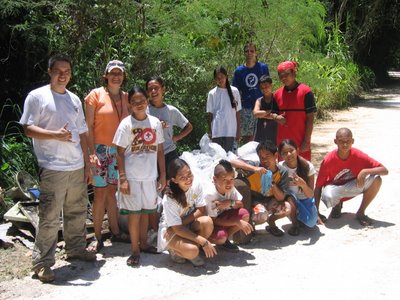 Today I took 10 Hopwood Junior High School students down to the Lao Lao Watershed for an outdoor classroom experience. Accompaning us were Bree, Doug, and Sharleen, 3 teachers from Hopwood, Jeremy Shaw from DEQ and Joleen, one of DEQ's new interns.
Today I took 10 Hopwood Junior High School students down to the Lao Lao Watershed for an outdoor classroom experience. Accompaning us were Bree, Doug, and Sharleen, 3 teachers from Hopwood, Jeremy Shaw from DEQ and Joleen, one of DEQ's new interns.
 We took them to the revegetation area and taught them about watershed science, erosion, and the effects of burning on the soil. Then we hiked over to a burned area that is adjacent to an unburned area and we discussed the difference in the soils.
We took them to the revegetation area and taught them about watershed science, erosion, and the effects of burning on the soil. Then we hiked over to a burned area that is adjacent to an unburned area and we discussed the difference in the soils. After our hour long hike we drove down to the dive site and looked at one of the stream crossings for the road and then at the spot where the stream drains into the ocean.
After our hour long hike we drove down to the dive site and looked at one of the stream crossings for the road and then at the spot where the stream drains into the ocean.After that, we cleaned up stream #4.
We learned that what we do on the land, affects what goes on in the water. We witnessed the effects that burnings have on erosion and sediment loads in Lao Lao Bay and then we witnessed first hand what effects littering and illegal dumping have on the beauty of the island.
Then we did something about it.
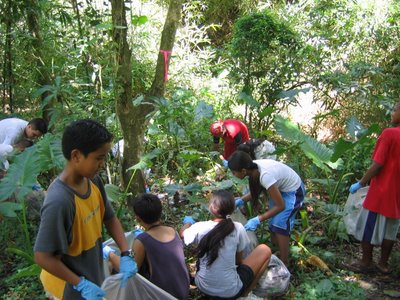 I'll post a few more pictures when I get back from Guam (I'm going there for the weekend), but would you look at all of that garbage:
I'll post a few more pictures when I get back from Guam (I'm going there for the weekend), but would you look at all of that garbage: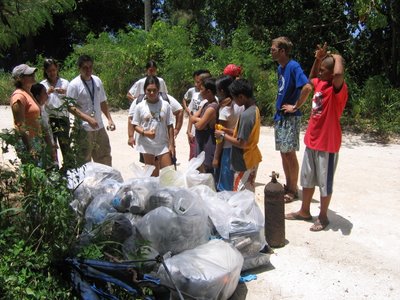 All this garbage was pulled out of ONE stream. It is pretty sad that we have to rely on a bunch of 8th graders to pick it up for us. We're lucky that they're willing (and excited) to go out and do this kind of stuff. All of these kids are on there summer vacation, but instead of spending the day playing PS2, they chose to learn how to help improve our island and our environment.
All this garbage was pulled out of ONE stream. It is pretty sad that we have to rely on a bunch of 8th graders to pick it up for us. We're lucky that they're willing (and excited) to go out and do this kind of stuff. All of these kids are on there summer vacation, but instead of spending the day playing PS2, they chose to learn how to help improve our island and our environment.Thank you, Hopwood Junior High School! We collected over 440 lbs of trash!
Thursday, June 15, 2006
Thank You, Google
About 48 hours ago, Google launched Google Earth Release 4 Beta. They just made my life better.
You see, if you had looked on Google Earth for Saipan or any of the other Northern Mariana Islands only 49 hours ago, you would have seen a string of smudgy green dots several thousand miles southeast of Japan.
Not anymore.
Now Google Earth has high definition satellite pictures covering every single island in the Archipelago...from Guam to Maug.
We can use this completely FREE online tool to look at the Marianas Resource Conservation & Development Council Office on Beach Road:
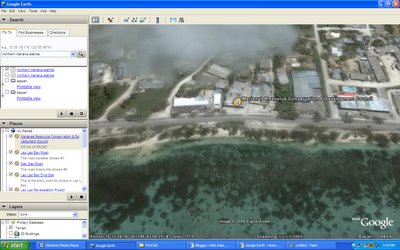 But even better, we can use it to make satellite images of the areas on island where we are working. Like, let's say, Lao Lao Bay:
But even better, we can use it to make satellite images of the areas on island where we are working. Like, let's say, Lao Lao Bay:
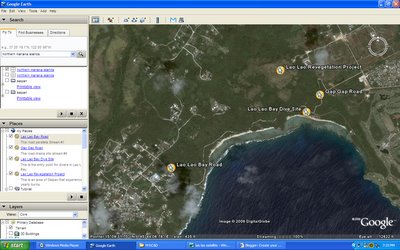 I've marked off the revegetation area (its the area currently not vegetated!), the dive site, the road draining into Stream #1(Lao Lao Bay Road), and the road draining into Stream #9(Gap Gap Road). This should help our off island readers visualize where we are working.
I've marked off the revegetation area (its the area currently not vegetated!), the dive site, the road draining into Stream #1(Lao Lao Bay Road), and the road draining into Stream #9(Gap Gap Road). This should help our off island readers visualize where we are working.
Technorati Tags: google earth, saipan
You see, if you had looked on Google Earth for Saipan or any of the other Northern Mariana Islands only 49 hours ago, you would have seen a string of smudgy green dots several thousand miles southeast of Japan.
Not anymore.
Now Google Earth has high definition satellite pictures covering every single island in the Archipelago...from Guam to Maug.
We can use this completely FREE online tool to look at the Marianas Resource Conservation & Development Council Office on Beach Road:
 But even better, we can use it to make satellite images of the areas on island where we are working. Like, let's say, Lao Lao Bay:
But even better, we can use it to make satellite images of the areas on island where we are working. Like, let's say, Lao Lao Bay: I've marked off the revegetation area (its the area currently not vegetated!), the dive site, the road draining into Stream #1(Lao Lao Bay Road), and the road draining into Stream #9(Gap Gap Road). This should help our off island readers visualize where we are working.
I've marked off the revegetation area (its the area currently not vegetated!), the dive site, the road draining into Stream #1(Lao Lao Bay Road), and the road draining into Stream #9(Gap Gap Road). This should help our off island readers visualize where we are working.Technorati Tags: google earth, saipan
Monday, June 12, 2006
MRC&D in the News
Marianas Variety, Monday, June 12, 2006
Beautify CNMI Needs Volunteers
By Cherrie Anne E. Villahermosa
Variety News Staff
BEAUTIFY CNMI, a group of government agencies and private sector organizations, needs volunteers for its recycling and tree planting projects.
The group held its first press conference on Friday in the Division of Environmental Quality’s conference room where the heads of various subcommittees announced their projects.
The restoration subcommittee chaired by Ken Kramer of the Marianas Resource Conservation & Development will do some tree planting on Beach and Middle Roads and other areas and needs volunteers.
Angelo Villagomez, who spoke on behalf of Kramer, said their subcomittee will plant trees from June 19 to 22.
The recycling subcommittee chaired by Tina Sablan of DEQ is also seeking volunteers for the recycling station at the Liberation carnival grounds in Garapan.
Sablan said the recycling station is doing well but still needs help.
According to Sablan, volunteers will monitor bins, explain the recycling project to passersby, go out and collect plastic bottles and cans from the carnival grounds and tables, as well as ensure that the vendors who sponsor the tent are mentioned by emcees during public service announcements.
Sablan said they also welcome assistance in terms of food and drinks for the volunteers.
For more information, call DEQ at 664-8500 and Marianas Resource Conservation & Development at 236-0894.
Beautify CNMI Needs Volunteers
By Cherrie Anne E. Villahermosa
Variety News Staff
BEAUTIFY CNMI, a group of government agencies and private sector organizations, needs volunteers for its recycling and tree planting projects.
The group held its first press conference on Friday in the Division of Environmental Quality’s conference room where the heads of various subcommittees announced their projects.
The restoration subcommittee chaired by Ken Kramer of the Marianas Resource Conservation & Development will do some tree planting on Beach and Middle Roads and other areas and needs volunteers.
Angelo Villagomez, who spoke on behalf of Kramer, said their subcomittee will plant trees from June 19 to 22.
The recycling subcommittee chaired by Tina Sablan of DEQ is also seeking volunteers for the recycling station at the Liberation carnival grounds in Garapan.
Sablan said the recycling station is doing well but still needs help.
According to Sablan, volunteers will monitor bins, explain the recycling project to passersby, go out and collect plastic bottles and cans from the carnival grounds and tables, as well as ensure that the vendors who sponsor the tent are mentioned by emcees during public service announcements.
Sablan said they also welcome assistance in terms of food and drinks for the volunteers.
For more information, call DEQ at 664-8500 and Marianas Resource Conservation & Development at 236-0894.
Saturday, June 10, 2006
Beautify CNMI!
RC&D is working with recently formed Beautify CNMI on their restoration efforts on Saipan. Ken Kramer, the acting RC&D Coordinator, has even taken a leadership role and volunteered to chair the Restoration Subcommittee.
Although the goals of Beautify CNMI are wide, some of the activities planned by the Restoration Subcommittee include tree plantings and revegetation. The goals of our Coral Reef Outreach Project include tree plantings and revegetation, so our involvement will have the double benefit of helping us and them.
This past week, Beautify CNMI had their monthly meeting and a press conference to announce their plans for the upcoming months. On Thursday, Ken presented the Restoration Subcommittee report to the rest of the Beautify CNMI members. Then on Friday, since Ken was off-island, I gave the report to the press.
Beautify CNMI recieved some press for the event:
Ruth L. Tighe discussed the group in her weekly online column:
Although the goals of Beautify CNMI are wide, some of the activities planned by the Restoration Subcommittee include tree plantings and revegetation. The goals of our Coral Reef Outreach Project include tree plantings and revegetation, so our involvement will have the double benefit of helping us and them.
This past week, Beautify CNMI had their monthly meeting and a press conference to announce their plans for the upcoming months. On Thursday, Ken presented the Restoration Subcommittee report to the rest of the Beautify CNMI members. Then on Friday, since Ken was off-island, I gave the report to the press.
Beautify CNMI recieved some press for the event:
Ruth L. Tighe discussed the group in her weekly online column:
One group focusing on positive certainties is the newly-formed Beautification Task Force, brought together by Congresswoman Cinta Kaipat. Yesterday it had its second monthly meeting, and the accomplishments achieved over such a short period of time were impressive indeed. The re-cycling sub-committee reported that a re-cycling station has been set up at the Liberation Day fair grounds as well as re-cycling bins, and that efforts are under way to do the same on Managaha, as well as in all schools. The restoration subcommittee announced that two tree-plantings have been scheduled, one from 6/19-22 to replace flame trees on Beach Road and another on 8/12 and 8/26 to plant trees along Middle Road. The litter subcommittee is focusing on enforcement of litter laws, and promoting communication among enforcement officers in the various agencies; declaration of a "zero-tolerance" week is upcoming.The Saipan Tribune published a front page article (and a picture!):
The "Beautify CNMI," a coalition of different government agencies and private sector, was officially launched yesterday with the announcement of various
ongoing and upcoming community projects.
Friday, June 09, 2006
Marianas Variety Article
The Marianas Variety does not have an archive system, so I am reposting this article in its entirety. This article appeared in the Friday, June 9, 2006 issue.
Wanted: Earth Team Volunteers
By Cherrie Anne E. Villahermosa
Variety News Staff
THE Natural Resources Conservation Service and the Marianas Resource Conservation and Development Council are now looking for volunteers that will help carry out the agency’s mission, which is the conservation and improvement of the environment and natural resources.
Staff members of the organizations are promoting the Earth Team Volunteer Program which has been in existence since 1981.
Antonette G. Tornito, Earth Team state coordinator for the Pacific Islands Area-Pacific Basin, said they are coordinating with the Division of Environmental Quality, Coastal Resources Management, the Department of Public Works and other concerned agencies to encourage the spirit of volunteerism in the CNMI.
Tornito said they want to involve the community in conserving, maintaining and improving natural resources.
She said the job of conserving natural resources cannot be done by government alone.
The collective talents and energies of private individuals and groups are also needed, she added.
Tornito who attended the committee meeting of the Beautify CNMI program held in the DEQ conference room yesterday, encouraged the heads of each subcommittee and representatives from different government agencies to participate in the Earth Team Volunteer Program.
A volunteer must be 14 years old or older.
Volunteers will not get a salary but the Natural Resources Conservation Service can pay for incidental expenses that volunteers may incur.
Tornito said the NRCS will also provide protection to volunteers under the Worker’s Compensation Program and Tort Claims Act.
Tornito said 34,432 volunteers across the nation joined in 2005.
Wanted: Earth Team Volunteers
By Cherrie Anne E. Villahermosa
Variety News Staff
THE Natural Resources Conservation Service and the Marianas Resource Conservation and Development Council are now looking for volunteers that will help carry out the agency’s mission, which is the conservation and improvement of the environment and natural resources.
Staff members of the organizations are promoting the Earth Team Volunteer Program which has been in existence since 1981.
Antonette G. Tornito, Earth Team state coordinator for the Pacific Islands Area-Pacific Basin, said they are coordinating with the Division of Environmental Quality, Coastal Resources Management, the Department of Public Works and other concerned agencies to encourage the spirit of volunteerism in the CNMI.
Tornito said they want to involve the community in conserving, maintaining and improving natural resources.
She said the job of conserving natural resources cannot be done by government alone.
The collective talents and energies of private individuals and groups are also needed, she added.
Tornito who attended the committee meeting of the Beautify CNMI program held in the DEQ conference room yesterday, encouraged the heads of each subcommittee and representatives from different government agencies to participate in the Earth Team Volunteer Program.
A volunteer must be 14 years old or older.
Volunteers will not get a salary but the Natural Resources Conservation Service can pay for incidental expenses that volunteers may incur.
Tornito said the NRCS will also provide protection to volunteers under the Worker’s Compensation Program and Tort Claims Act.
Tornito said 34,432 volunteers across the nation joined in 2005.
Thursday, June 08, 2006
Bird Island MPA
Marine Protected Areas (MPA) are marine areas where the harvesting of natural resources is limited. The reasons for creating MPAs are many, but on Saipan there are primarily two strong arguments. First of all, on Saipan, the MPAs are areas that are important for the local tourist economy. Many tourists identify Saipan's beautiful coral reefs and sandy beaches as the main reason for their visit. The MPAs ensure that an important source of revenue for the islands (i.e. tourist dollars) are protected in the present and in the future. Secondly, the MPAs serve as sanctuaries for fish, trochus, octopus, and other species that are culturally important for the local people. Protecting these species will ensure that Chamorros and Carolinians, the indigenous people of the CNMI, will be able to continue their cultural practices, such as talaya and spear fishing, for generations to come.
The following map, from the CNMI Division of Fish and Wildlife website, illustrates the location of the MPAs on Saipan:
 While MPAs protect submerged lands, Wildlife Conservation Areas (WCA) protect areas that are on land. Comparing the following map to the previous map, you can see that the WCAs and the MPAs were designed in conjunction with one another to protect both the coral reefs and the watersheds that are economically and culturally important to Saipan:
While MPAs protect submerged lands, Wildlife Conservation Areas (WCA) protect areas that are on land. Comparing the following map to the previous map, you can see that the WCAs and the MPAs were designed in conjunction with one another to protect both the coral reefs and the watersheds that are economically and culturally important to Saipan:
 There are five MPAs in Saipan. I am going to highlight each of the MPAs on this blog. This is the second:
There are five MPAs in Saipan. I am going to highlight each of the MPAs on this blog. This is the second:
 This is the view of Bird Island from the Bird Island Lookout.
This is the view of Bird Island from the Bird Island Lookout.
The Bird Island Sanctuary was created in 2000 with the enactment of Public Law #12-46 (the same law that created the Forbidden Island Sanctuary). It stretches from right outside the grotto to just below the Bird Island Lookout (see map above, but it is pretty much everything you see in the above photo).
The two areas most popular with tourists are the Grotto and the Bird Island Lookout. It is also possible to hike down to the island, but very few people attempt to do so.
If you want to hike down to Bird Island Beach, here are the rules for visiting:
 The head of the trail down to Bird Island Beach is at the end of a grassy road about half way between the Grotto and the Lookout. It is easy to miss, because it is so small, but it is the only road between the Grotto and the Lookout, so just keep looking.
The head of the trail down to Bird Island Beach is at the end of a grassy road about half way between the Grotto and the Lookout. It is easy to miss, because it is so small, but it is the only road between the Grotto and the Lookout, so just keep looking.
The beginning of the trail is marked with a small green sign that reads "Conservation Area." The hike down takes about 15 minutes. It is not nearly as steep as the trail down to Forbidden Island, but it is a little difficult at times. The trail can be very rocky and very muddy, especially if it has been raining.
Right before you step out onto the beach you have to walk through what looks like a dry stream bed. This is a great place to find hermit crabs and juvenile coconut crabs.
 Once you walk out onto the beach, Bird Island will be to your right and you will see the beach stretching in both directions. If you head over to your right there are two caves that can serve as shelter, but you can plop down anywhere on the sand.
Once you walk out onto the beach, Bird Island will be to your right and you will see the beach stretching in both directions. If you head over to your right there are two caves that can serve as shelter, but you can plop down anywhere on the sand.
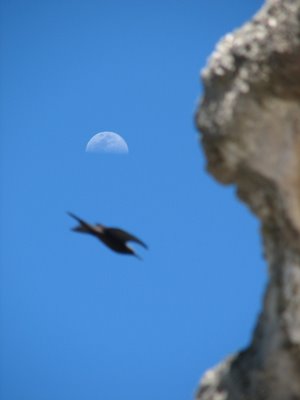 The Japanese used to call Bird Island "Moon Viewing Island." I tried to take a photo that incorporated the moon, the birds, and the island. The photo pictured above is what I came up with. Most of the birds flying around the island are black noddies. You can tell them apart from the brown noddies because they are smaller and have a white spot on their heads. They are all over the island. I can see why they named the place Bird Island.
The Japanese used to call Bird Island "Moon Viewing Island." I tried to take a photo that incorporated the moon, the birds, and the island. The photo pictured above is what I came up with. Most of the birds flying around the island are black noddies. You can tell them apart from the brown noddies because they are smaller and have a white spot on their heads. They are all over the island. I can see why they named the place Bird Island.
 I took a few pictures of some other birds, too. Here are just a few:
I took a few pictures of some other birds, too. Here are just a few:
It is very easy to walk onto the island. The water between the beach and the island gets no deeper than 4 feet, even during high tide. You might get a little wet, but it is worth it because of all the interesting things on the island. I still don't have an underwater camera, so you will have to make do with above water shots for a few more weeks. Here you go:


 After you visit the tide pools, the next best activity is to go snorkeling. The water inside the reef flat is deep enough and there are plenty of fish to make for a very pleasing swim, but for those with a death wish, the option of going outside the reef is available. If you can't tell from my subtlety, I don't recommend swimming outside the reef. The waves are really strong and the currents are even stronger. The water also drops to about 100 feet just a few meters off the shore.
After you visit the tide pools, the next best activity is to go snorkeling. The water inside the reef flat is deep enough and there are plenty of fish to make for a very pleasing swim, but for those with a death wish, the option of going outside the reef is available. If you can't tell from my subtlety, I don't recommend swimming outside the reef. The waves are really strong and the currents are even stronger. The water also drops to about 100 feet just a few meters off the shore.
Bird Island is also a great place to picnic. There are no facilities, but who needs a picnic table when you have a sandy white beach?
Then, if you're not too tired after your trip down to Bird Island, you might want to head over to the Grotto for a quick dip.
The Grotto is a sunken pool whose underwater passages lead to the ocean. Sunlight shining in through the caverns gives the water an unearthly blue hue. Pictures don't do it justice; you have to see it to believe it...but you have to walk down an extremely long stair case to see it (which you eventually have to walk back up).
The Grotto has been rated as one of the World's best diving spots, but you don't have to be a diver to go there. Many people just go there for a quick swim.
WARNING:
THE GROTTO CAN BE A DANGEROUS PLACE TO VISIT. PEOPLE HAVE DIED THERE. USE EXTREME CAUTION WHEN YOU GO THERE, AND TRY TO BRING SOMEONE WHO HAS BEEN DOWN THERE BEFORE AND KNOWS WHAT THEY ARE DOING, ESPECIALLY IF YOU ARE GOING TO ATTEMPT A DIVE.
Again I have to apologize for not having an underwater camera. Here are some shots from above the waterline:
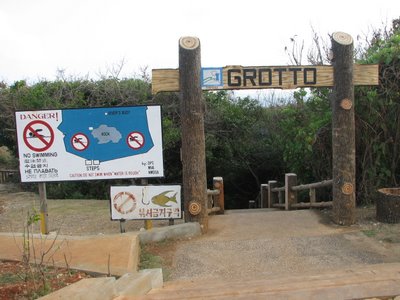





 Can you see the little fish in the second to last photo? It is kind of towards the top in the center, sitting on the rock.
Can you see the little fish in the second to last photo? It is kind of towards the top in the center, sitting on the rock.
I'll take plenty of pictures of underwater sea life once the RC&D camera arrives. I'll post a lot of them at our main website at www.hafa-adai.org, but I'll add the best ones to this blog.
The following map, from the CNMI Division of Fish and Wildlife website, illustrates the location of the MPAs on Saipan:
 While MPAs protect submerged lands, Wildlife Conservation Areas (WCA) protect areas that are on land. Comparing the following map to the previous map, you can see that the WCAs and the MPAs were designed in conjunction with one another to protect both the coral reefs and the watersheds that are economically and culturally important to Saipan:
While MPAs protect submerged lands, Wildlife Conservation Areas (WCA) protect areas that are on land. Comparing the following map to the previous map, you can see that the WCAs and the MPAs were designed in conjunction with one another to protect both the coral reefs and the watersheds that are economically and culturally important to Saipan: There are five MPAs in Saipan. I am going to highlight each of the MPAs on this blog. This is the second:
There are five MPAs in Saipan. I am going to highlight each of the MPAs on this blog. This is the second:Bird Island Sanctuary
 This is the view of Bird Island from the Bird Island Lookout.
This is the view of Bird Island from the Bird Island Lookout.The Bird Island Sanctuary was created in 2000 with the enactment of Public Law #12-46 (the same law that created the Forbidden Island Sanctuary). It stretches from right outside the grotto to just below the Bird Island Lookout (see map above, but it is pretty much everything you see in the above photo).
The two areas most popular with tourists are the Grotto and the Bird Island Lookout. It is also possible to hike down to the island, but very few people attempt to do so.
If you want to hike down to Bird Island Beach, here are the rules for visiting:
 The head of the trail down to Bird Island Beach is at the end of a grassy road about half way between the Grotto and the Lookout. It is easy to miss, because it is so small, but it is the only road between the Grotto and the Lookout, so just keep looking.
The head of the trail down to Bird Island Beach is at the end of a grassy road about half way between the Grotto and the Lookout. It is easy to miss, because it is so small, but it is the only road between the Grotto and the Lookout, so just keep looking.The beginning of the trail is marked with a small green sign that reads "Conservation Area." The hike down takes about 15 minutes. It is not nearly as steep as the trail down to Forbidden Island, but it is a little difficult at times. The trail can be very rocky and very muddy, especially if it has been raining.
Right before you step out onto the beach you have to walk through what looks like a dry stream bed. This is a great place to find hermit crabs and juvenile coconut crabs.
 Once you walk out onto the beach, Bird Island will be to your right and you will see the beach stretching in both directions. If you head over to your right there are two caves that can serve as shelter, but you can plop down anywhere on the sand.
Once you walk out onto the beach, Bird Island will be to your right and you will see the beach stretching in both directions. If you head over to your right there are two caves that can serve as shelter, but you can plop down anywhere on the sand. The Japanese used to call Bird Island "Moon Viewing Island." I tried to take a photo that incorporated the moon, the birds, and the island. The photo pictured above is what I came up with. Most of the birds flying around the island are black noddies. You can tell them apart from the brown noddies because they are smaller and have a white spot on their heads. They are all over the island. I can see why they named the place Bird Island.
The Japanese used to call Bird Island "Moon Viewing Island." I tried to take a photo that incorporated the moon, the birds, and the island. The photo pictured above is what I came up with. Most of the birds flying around the island are black noddies. You can tell them apart from the brown noddies because they are smaller and have a white spot on their heads. They are all over the island. I can see why they named the place Bird Island. I took a few pictures of some other birds, too. Here are just a few:
I took a few pictures of some other birds, too. Here are just a few:It is very easy to walk onto the island. The water between the beach and the island gets no deeper than 4 feet, even during high tide. You might get a little wet, but it is worth it because of all the interesting things on the island. I still don't have an underwater camera, so you will have to make do with above water shots for a few more weeks. Here you go:


 After you visit the tide pools, the next best activity is to go snorkeling. The water inside the reef flat is deep enough and there are plenty of fish to make for a very pleasing swim, but for those with a death wish, the option of going outside the reef is available. If you can't tell from my subtlety, I don't recommend swimming outside the reef. The waves are really strong and the currents are even stronger. The water also drops to about 100 feet just a few meters off the shore.
After you visit the tide pools, the next best activity is to go snorkeling. The water inside the reef flat is deep enough and there are plenty of fish to make for a very pleasing swim, but for those with a death wish, the option of going outside the reef is available. If you can't tell from my subtlety, I don't recommend swimming outside the reef. The waves are really strong and the currents are even stronger. The water also drops to about 100 feet just a few meters off the shore.Bird Island is also a great place to picnic. There are no facilities, but who needs a picnic table when you have a sandy white beach?
Then, if you're not too tired after your trip down to Bird Island, you might want to head over to the Grotto for a quick dip.
The Grotto is a sunken pool whose underwater passages lead to the ocean. Sunlight shining in through the caverns gives the water an unearthly blue hue. Pictures don't do it justice; you have to see it to believe it...but you have to walk down an extremely long stair case to see it (which you eventually have to walk back up).
The Grotto has been rated as one of the World's best diving spots, but you don't have to be a diver to go there. Many people just go there for a quick swim.
WARNING:
THE GROTTO CAN BE A DANGEROUS PLACE TO VISIT. PEOPLE HAVE DIED THERE. USE EXTREME CAUTION WHEN YOU GO THERE, AND TRY TO BRING SOMEONE WHO HAS BEEN DOWN THERE BEFORE AND KNOWS WHAT THEY ARE DOING, ESPECIALLY IF YOU ARE GOING TO ATTEMPT A DIVE.
Again I have to apologize for not having an underwater camera. Here are some shots from above the waterline:






 Can you see the little fish in the second to last photo? It is kind of towards the top in the center, sitting on the rock.
Can you see the little fish in the second to last photo? It is kind of towards the top in the center, sitting on the rock.I'll take plenty of pictures of underwater sea life once the RC&D camera arrives. I'll post a lot of them at our main website at www.hafa-adai.org, but I'll add the best ones to this blog.
Wednesday, June 07, 2006
NRCS Fire Brochure
Ken Kramer, acting coordinator for Marianas RC&D, recommended that I post the following brochure on this blog. It may be a little hard to read, but clicking on each photo will bring up a larger version.
The brochure was written by NRCS for Guam, but many of the issues are the same in Saipan, so it is relevant to the situation in Lao Lao Bay.
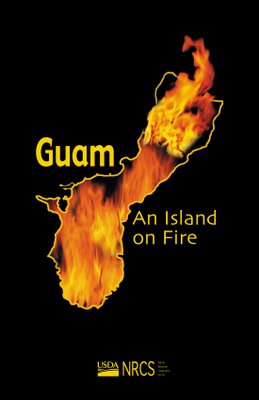
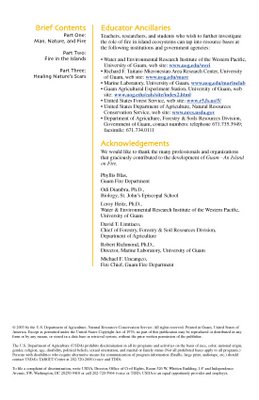
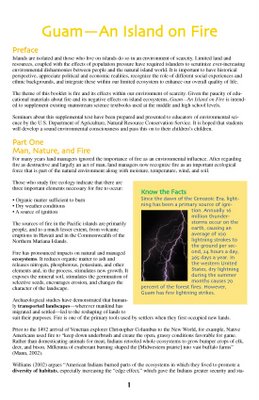
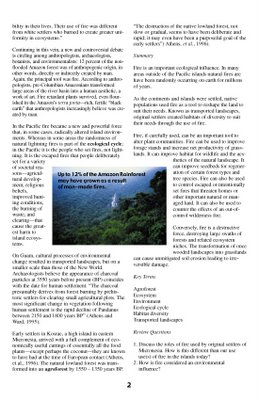
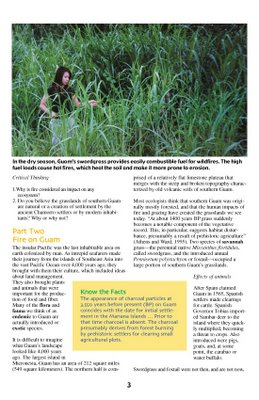
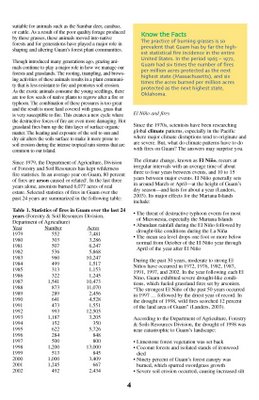
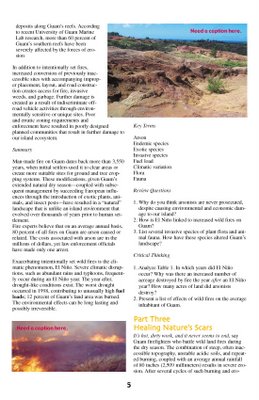
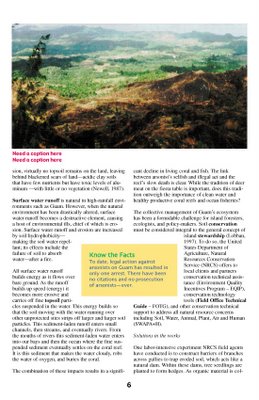
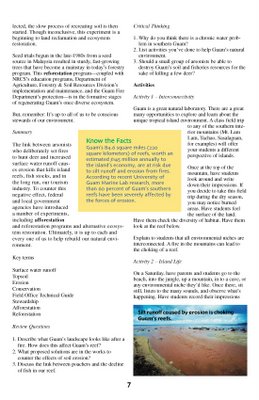
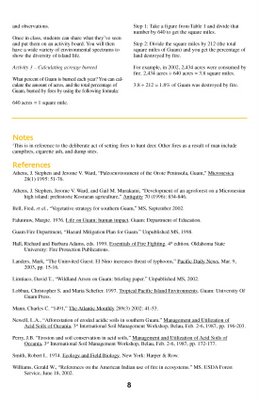
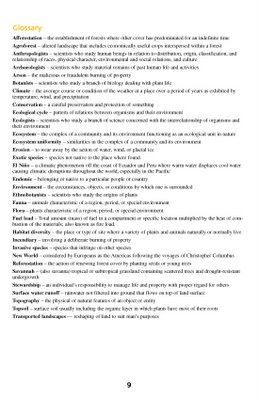

The brochure was written by NRCS for Guam, but many of the issues are the same in Saipan, so it is relevant to the situation in Lao Lao Bay.












Subscribe to:
Posts (Atom)





